Angular Momentum
Angular Momentum
Learning Objectives
By the end of this section, you will be able to:
- Describe the vector nature of angular momentum
- Find the total angular momentum and torque about a designated origin of a system of particles
- Calculate the angular momentum of a rigid body rotating about a fixed axis
- Calculate the torque on a rigid body rotating about a fixed axis
- Use conservation of angular momentum in the analysis of objects that change their rotation rate
Why does Earth keep on spinning? What started it spinning to begin with? Why doesn’t Earth’s gravitational attraction not bring the Moon crashing in toward Earth? And how does an ice skater manage to spin faster and faster simply by pulling her arms in? Why does she not have to exert a torque to spin faster?
The answer is in a new conserved quantity, since all of these scenarios are in closed systems. This new quantity, angular momentum, is analogous to linear momentum. In this chapter, we first define and then explore angular momentum from a variety of viewpoints. First, however, we investigate the angular momentum of a single particle. This allows us to develop angular momentum for a system of particles and for a rigid body that is cylindrically symmetric.
Angular Momentum of a Single Particle
(Figure) shows a particle at a position ![]() with linear momentum
with linear momentum ![]() with respect to the origin. Even if the particle is not rotating about the origin, we can still define an angular momentum in terms of the position vector and the linear momentum.
with respect to the origin. Even if the particle is not rotating about the origin, we can still define an angular momentum in terms of the position vector and the linear momentum.
The angular momentum ![]() of a particle is defined as the cross-product of
of a particle is defined as the cross-product of ![]() and
and ![]() , and is perpendicular to the plane containing
, and is perpendicular to the plane containing ![]() and
and ![]()
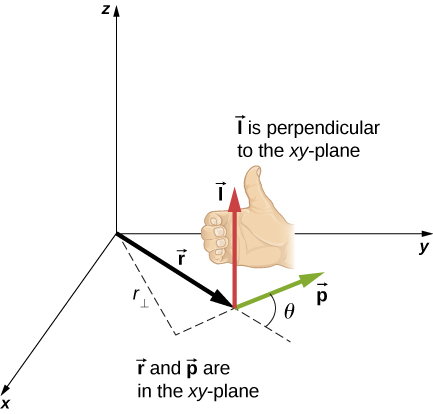
The intent of choosing the direction of the angular momentum to be perpendicular to the plane containing ![]() and
and ![]() is similar to choosing the direction of torque to be perpendicular to the plane of
is similar to choosing the direction of torque to be perpendicular to the plane of ![]() as discussed in Fixed-Axis Rotation. The magnitude of the angular momentum is found from the definition of the cross-product,
as discussed in Fixed-Axis Rotation. The magnitude of the angular momentum is found from the definition of the cross-product,
where ![]() is the angle between
is the angle between ![]() and
and ![]() The units of angular momentum are
The units of angular momentum are ![]() .
.
As with the definition of torque, we can define a lever arm ![]() that is the perpendicular distance from the momentum vector
that is the perpendicular distance from the momentum vector ![]() to the origin,
to the origin, ![]() With this definition, the magnitude of the angular momentum becomes
With this definition, the magnitude of the angular momentum becomes
We see that if the direction of ![]() is such that it passes through the origin, then
is such that it passes through the origin, then ![]() and the angular momentum is zero because the lever arm is zero. In this respect, the magnitude of the angular momentum depends on the choice of origin.
and the angular momentum is zero because the lever arm is zero. In this respect, the magnitude of the angular momentum depends on the choice of origin.
If we take the time derivative of the angular momentum, we arrive at an expression for the torque on the particle:
Here we have used the definition of ![]() and the fact that a vector crossed into itself is zero. From Newton’s second law,
and the fact that a vector crossed into itself is zero. From Newton’s second law, ![]() the net force acting on the particle, and the definition of the net torque, we can write
the net force acting on the particle, and the definition of the net torque, we can write
Note the similarity with the linear result of Newton’s second law, ![]() . The following problem-solving strategy can serve as a guideline for calculating the angular momentum of a particle.
. The following problem-solving strategy can serve as a guideline for calculating the angular momentum of a particle.
- Choose a coordinate system about which the angular momentum is to be calculated.
- Write down the radius vector to the point particle in unit vector notation.
- Write the linear momentum vector of the particle in unit vector notation.
- Take the cross product
 and use the right-hand rule to establish the direction of the angular momentum vector.
and use the right-hand rule to establish the direction of the angular momentum vector. - See if there is a time dependence in the expression of the angular momentum vector. If there is, then a torque exists about the origin, and use
 to calculate the torque. If there is no time dependence in the expression for the angular momentum, then the net torque is zero.
to calculate the torque. If there is no time dependence in the expression for the angular momentum, then the net torque is zero.
Angular Momentum and Torque on a Meteor
A meteor enters Earth’s atmosphere ((Figure)) and is observed by someone on the ground before it burns up in the atmosphere. The vector ![]() gives the position of the meteor with respect to the observer. At the instant the observer sees the meteor, it has linear momentum
gives the position of the meteor with respect to the observer. At the instant the observer sees the meteor, it has linear momentum ![]() , and it is accelerating at a constant
, and it is accelerating at a constant ![]() along its path, which for our purposes can be taken as a straight line. (a) What is the angular momentum of the meteor about the origin, which is at the location of the observer? (b) What is the torque on the meteor about the origin?
along its path, which for our purposes can be taken as a straight line. (a) What is the angular momentum of the meteor about the origin, which is at the location of the observer? (b) What is the torque on the meteor about the origin?
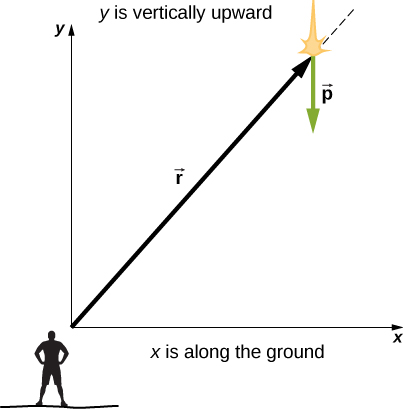
Strategy
We resolve the acceleration into x– and y-components and use the kinematic equations to express the velocity as a function of acceleration and time. We insert these expressions into the linear momentum and then calculate the angular momentum using the cross-product. Since the position and momentum vectors are in the xy-plane, we expect the angular momentum vector to be along the z-axis. To find the torque, we take the time derivative of the angular momentum.
Solution
The meteor is entering Earth’s atmosphere at an angle of ![]() below the horizontal, so the components of the acceleration in the x– and y-directions are
below the horizontal, so the components of the acceleration in the x– and y-directions are
We write the velocities using the kinematic equations.
- The angular momentum is
![Rendered by QuickLaTeX.com \begin{array}{cc}\hfill \stackrel{\to }{l}& =\stackrel{\to }{r}\phantom{\rule{0.2em}{0ex}}×\phantom{\rule{0.2em}{0ex}}\stackrel{\to }{p}=\left(25.0\phantom{\rule{0.2em}{0ex}}\text{km}\stackrel{^}{i}+25.0\phantom{\rule{0.2em}{0ex}}\text{km}\stackrel{^}{j}\right)\phantom{\rule{0.2em}{0ex}}×\phantom{\rule{0.2em}{0ex}}15.0\phantom{\rule{0.2em}{0ex}}\text{kg}\left(0\stackrel{^}{i}+{v}_{y}\stackrel{^}{j}\right)\hfill \\ & =15.0\phantom{\rule{0.2em}{0ex}}\text{kg}\left[25.0\phantom{\rule{0.2em}{0ex}}\text{km}\left({v}_{y}\right)\stackrel{^}{k}\right]\hfill \\ & =15.0\phantom{\rule{0.2em}{0ex}}\text{kg[}2.50\phantom{\rule{0.2em}{0ex}}×\phantom{\rule{0.2em}{0ex}}{10}^{4}\phantom{\rule{0.2em}{0ex}}\text{m}\left(-2.0\phantom{\rule{0.2em}{0ex}}×\phantom{\rule{0.2em}{0ex}}{10}^{3}\phantom{\rule{0.2em}{0ex}}\text{m}\text{/}\text{s}-\left(2.0\phantom{\rule{0.2em}{0ex}}\text{m}\text{/}{\text{s}}^{2}\right)t\right)\stackrel{^}{k}\right].\hfill \end{array}](https://pressbooks.bccampus.ca/universityphysicssandboxbook1/wp-content/ql-cache/quicklatex.com-c4209f363e6f4cdb51bac61bccc604f1_l3.png)
At
 , the angular momentum of the meteor about the origin is
, the angular momentum of the meteor about the origin is![Rendered by QuickLaTeX.com {\stackrel{\to }{l}}_{0}=15.0\phantom{\rule{0.2em}{0ex}}\text{kg}\left[2.50\phantom{\rule{0.2em}{0ex}}×\phantom{\rule{0.2em}{0ex}}{10}^{4}\phantom{\rule{0.2em}{0ex}}\text{m}\left(-2.0\phantom{\rule{0.2em}{0ex}}×\phantom{\rule{0.2em}{0ex}}{10}^{3}\phantom{\rule{0.2em}{0ex}}\text{m}\text{/}\text{s}\right)\stackrel{^}{k}\right]=7.50\phantom{\rule{0.2em}{0ex}}×\phantom{\rule{0.2em}{0ex}}{10}^{8}\phantom{\rule{0.2em}{0ex}}\text{kg}·{\text{m}}^{2}\text{/}\text{s}\left(\text{−}\stackrel{^}{k}\right).](https://pressbooks.bccampus.ca/universityphysicssandboxbook1/wp-content/ql-cache/quicklatex.com-d8a813c89acad97c9a89d51a1691da94_l3.png)
This is the instant that the observer sees the meteor.
- To find the torque, we take the time derivative of the angular momentum. Taking the time derivative of
 as a function of time, which is the second equation immediately above, we have
as a function of time, which is the second equation immediately above, we have

Then, since
 , we have
, we have
The units of torque are given as newton-meters, not to be confused with joules. As a check, we note that the lever arm is the x-component of the vector
 in (Figure) since it is perpendicular to the force acting on the meteor, which is along its path. By Newton’s second law, this force is
in (Figure) since it is perpendicular to the force acting on the meteor, which is along its path. By Newton’s second law, this force is
The lever arm is

Thus, the torque is

Significance
Since the meteor is accelerating downward toward Earth, its radius and velocity vector are changing. Therefore, since ![]() , the angular momentum is changing as a function of time. The torque on the meteor about the origin, however, is constant, because the lever arm
, the angular momentum is changing as a function of time. The torque on the meteor about the origin, however, is constant, because the lever arm ![]() and the force on the meteor are constants. This example is important in that it illustrates that the angular momentum depends on the choice of origin about which it is calculated. The methods used in this example are also important in developing angular momentum for a system of particles and for a rigid body.
and the force on the meteor are constants. This example is important in that it illustrates that the angular momentum depends on the choice of origin about which it is calculated. The methods used in this example are also important in developing angular momentum for a system of particles and for a rigid body.
Check Your Understanding A proton spiraling around a magnetic field executes circular motion in the plane of the paper, as shown below. The circular path has a radius of 0.4 m and the proton has velocity ![]() . What is the angular momentum of the proton about the origin?
. What is the angular momentum of the proton about the origin?
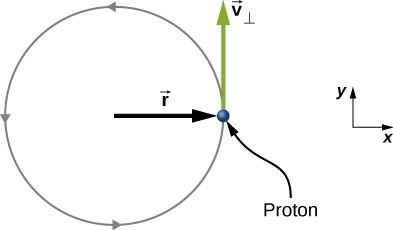
From the figure, we see that the cross product of the radius vector with the momentum vector gives a vector directed out of the page. Inserting the radius and momentum into the expression for the angular momentum, we have
![]()
Angular Momentum of a System of Particles
The angular momentum of a system of particles is important in many scientific disciplines, one being astronomy. Consider a spiral galaxy, a rotating island of stars like our own Milky Way. The individual stars can be treated as point particles, each of which has its own angular momentum. The vector sum of the individual angular momenta give the total angular momentum of the galaxy. In this section, we develop the tools with which we can calculate the total angular momentum of a system of particles.
In the preceding section, we introduced the angular momentum of a single particle about a designated origin. The expression for this angular momentum is ![]() where the vector
where the vector ![]() is from the origin to the particle, and
is from the origin to the particle, and ![]() is the particle’s linear momentum. If we have a system of N particles, each with position vector from the origin given by
is the particle’s linear momentum. If we have a system of N particles, each with position vector from the origin given by ![]() and each having momentum
and each having momentum ![]() then the total angular momentum of the system of particles about the origin is the vector sum of the individual angular momenta about the origin. That is,
then the total angular momentum of the system of particles about the origin is the vector sum of the individual angular momenta about the origin. That is,
Similarly, if particle i is subject to a net torque ![]() about the origin, then we can find the net torque about the origin due to the system of particles by differentiating (Figure):
about the origin, then we can find the net torque about the origin due to the system of particles by differentiating (Figure):
The sum of the individual torques produces a net external torque on the system, which we designate ![]() Thus,
Thus,
(Figure) states that the rate of change of the total angular momentum of a system is equal to the net external torque acting on the system when both quantities are measured with respect to a given origin. (Figure) can be applied to any system that has net angular momentum, including rigid bodies, as discussed in the next section.
Angular Momentum of Three Particles
Referring to (Figure)(a), determine the total angular momentum due to the three particles about the origin. (b) What is the rate of change of the angular momentum?
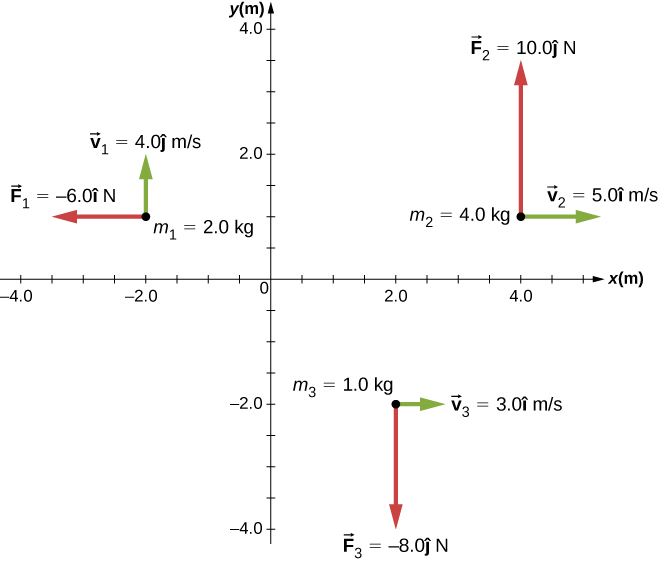
Strategy
Write down the position and momentum vectors for the three particles. Calculate the individual angular momenta and add them as vectors to find the total angular momentum. Then do the same for the torques.
Solution
- Particle 1:


Particle 2:
 ,
,
Particle 3:
 ,
,
We add the individual angular momenta to find the total about the origin:

- The individual forces and lever arms are
*** QuickLaTeX cannot compile formula: \begin{array}{c}{\stackrel{\to }{r}}_{1\perp }=1.0\phantom{\rule{0.2em}{0ex}}\text{m}\stackrel{^}{j},\phantom{\rule{0.5em}{0ex}}{\stackrel{\to }{F}}_{1}=-6.0\phantom{\rule{0.2em}{0ex}}\text{N}\stackrel{^}{i},\phantom{\rule{0.5em}{0ex}}{\stackrel{\to }{\tau }}_{1}=6.0\text{N}·\text{m}\stackrel{^}{k}\hfill \\ {\stackrel{\to }{r}}_{2\perp }=4.0\phantom{\rule{0.2em}{0ex}}\text{m}\stackrel{^}{i},\phantom{\rule{0.5em}{0ex}}{\stackrel{\to }{F}}_{2}=10.0\phantom{\rule{0.2em}{0ex}}\text{N}\stackrel{^}{j},\phantom{\rule{0.5em}{0ex}}{\stackrel{\to }{\tau }}_{2}=40.0\phantom{\rule{0.2em}{0ex}}\text{N}·\text{m}\stackrel{^}{k}\hfill \\ {\stackrel{\to }{r}}_{3\perp }=2.0\phantom{\rule{0.2em}{0ex}}\text{m}\stackrel{^}{i},\phantom{\rule{0.5em}{0ex}}{\stackrel{\to }{F}}_{3}=-8.0\phantom{\rule{0.2em}{0ex}}\text{N}\stackrel{^}{j},\phantom{\rule{0.5em}{0ex}}{\stackrel{\to }{\tau }}_{3}=-16.0\phantom{\rule{0.2em}{0ex}}\text{N}·\text{m}\stackrel{^}{k}.\hfill \end{array} *** Error message: Missing { inserted. leading text: ...m{\rule{0.2em}{0ex}}\text{m}\stackrel{^}{j} Missing { inserted. leading text: ...m{\rule{0.2em}{0ex}}\text{N}\stackrel{^}{i} Missing { inserted. leading text: ...}}_{1}=6.0\text{N}·\text{m}\stackrel{^}{k} Missing } inserted. leading text: ...0\text{N}·\text{m}\stackrel{^}{k}\hfill \\ Missing } inserted. leading text: ...0\text{N}·\text{m}\stackrel{^}{k}\hfill \\ Missing } inserted. leading text: ...0\text{N}·\text{m}\stackrel{^}{k}\hfill \\ Missing { inserted. leading text: ...m{\rule{0.2em}{0ex}}\text{m}\stackrel{^}{i} Missing { inserted. leading text: ...m{\rule{0.2em}{0ex}}\text{N}\stackrel{^}{j} Missing { inserted. leading text: ...2em}{0ex}}\text{N}·\text{m}\stackrel{^}{k} Missing } inserted. leading text: ...}\text{N}·\text{m}\stackrel{^}{k}\hfill \\Therefore:

Significance
This example illustrates the superposition principle for angular momentum and torque of a system of particles. Care must be taken when evaluating the radius vectors ![]() of the particles to calculate the angular momenta, and the lever arms,
of the particles to calculate the angular momenta, and the lever arms, ![]() to calculate the torques, as they are completely different quantities.
to calculate the torques, as they are completely different quantities.
Angular Momentum of a Rigid Body
We have investigated the angular momentum of a single particle, which we generalized to a system of particles. Now we can use the principles discussed in the previous section to develop the concept of the angular momentum of a rigid body. Celestial objects such as planets have angular momentum due to their spin and orbits around stars. In engineering, anything that rotates about an axis carries angular momentum, such as flywheels, propellers, and rotating parts in engines. Knowledge of the angular momenta of these objects is crucial to the design of the system in which they are a part.
To develop the angular momentum of a rigid body, we model a rigid body as being made up of small mass segments, ![]() In (Figure), a rigid body is constrained to rotate about the z-axis with angular velocity
In (Figure), a rigid body is constrained to rotate about the z-axis with angular velocity ![]() . All mass segments that make up the rigid body undergo circular motion about the z-axis with the same angular velocity. Part (a) of the figure shows mass segment
. All mass segments that make up the rigid body undergo circular motion about the z-axis with the same angular velocity. Part (a) of the figure shows mass segment ![]() with position vector
with position vector ![]() from the origin and radius
from the origin and radius ![]() to the z-axis. The magnitude of its tangential velocity is
to the z-axis. The magnitude of its tangential velocity is ![]() . Because the vectors
. Because the vectors ![]() are perpendicular to each other, the magnitude of the angular momentum of this mass segment is
are perpendicular to each other, the magnitude of the angular momentum of this mass segment is
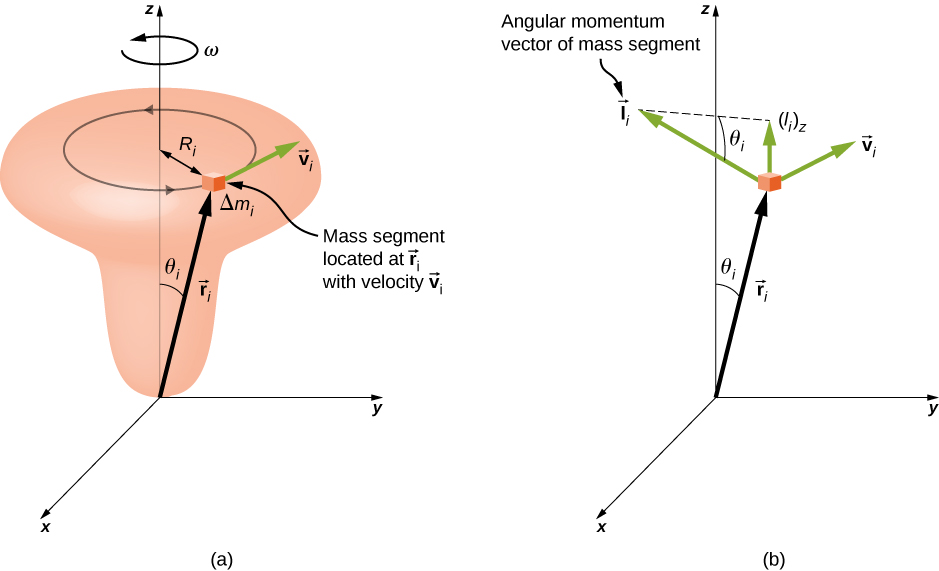
Using the right-hand rule, the angular momentum vector points in the direction shown in part (b). The sum of the angular momenta of all the mass segments contains components both along and perpendicular to the axis of rotation. Every mass segment has a perpendicular component of the angular momentum that will be cancelled by the perpendicular component of an identical mass segment on the opposite side of the rigid body. Thus, the component along the axis of rotation is the only component that gives a nonzero value when summed over all the mass segments. From part (b), the component of ![]() along the axis of rotation is
along the axis of rotation is
The net angular momentum of the rigid body along the axis of rotation is
The summation ![]() is simply the moment of inertia I of the rigid body about the axis of rotation. For a thin hoop rotating about an axis perpendicular to the plane of the hoop, all of the
is simply the moment of inertia I of the rigid body about the axis of rotation. For a thin hoop rotating about an axis perpendicular to the plane of the hoop, all of the ![]() ’s are equal to R so the summation reduces to
’s are equal to R so the summation reduces to ![]() which is the moment of inertia for a thin hoop found in (Figure). Thus, the magnitude of the angular momentum along the axis of rotation of a rigid body rotating with angular velocity
which is the moment of inertia for a thin hoop found in (Figure). Thus, the magnitude of the angular momentum along the axis of rotation of a rigid body rotating with angular velocity ![]() about the axis is
about the axis is
This equation is analogous to the magnitude of the linear momentum ![]() . The direction of the angular momentum vector is directed along the axis of rotation given by the right-hand rule.
. The direction of the angular momentum vector is directed along the axis of rotation given by the right-hand rule.
Angular Momentum of a Robot Arm
A robot arm on a Mars rover like Curiosity shown in (Figure) is 1.0 m long and has forceps at the free end to pick up rocks. The mass of the arm is 2.0 kg and the mass of the forceps is 1.0 kg. See (Figure). The robot arm and forceps move from rest to ![]() in 0.1 s. It rotates down and picks up a Mars rock that has mass 1.5 kg. The axis of rotation is the point where the robot arm connects to the rover. (a) What is the angular momentum of the robot arm by itself about the axis of rotation after 0.1 s when the arm has stopped accelerating? (b) What is the angular momentum of the robot arm when it has the Mars rock in its forceps and is rotating upwards? (c) When the arm does not have a rock in the forceps, what is the torque about the point where the arm connects to the rover when it is accelerating from rest to its final angular velocity?
in 0.1 s. It rotates down and picks up a Mars rock that has mass 1.5 kg. The axis of rotation is the point where the robot arm connects to the rover. (a) What is the angular momentum of the robot arm by itself about the axis of rotation after 0.1 s when the arm has stopped accelerating? (b) What is the angular momentum of the robot arm when it has the Mars rock in its forceps and is rotating upwards? (c) When the arm does not have a rock in the forceps, what is the torque about the point where the arm connects to the rover when it is accelerating from rest to its final angular velocity?
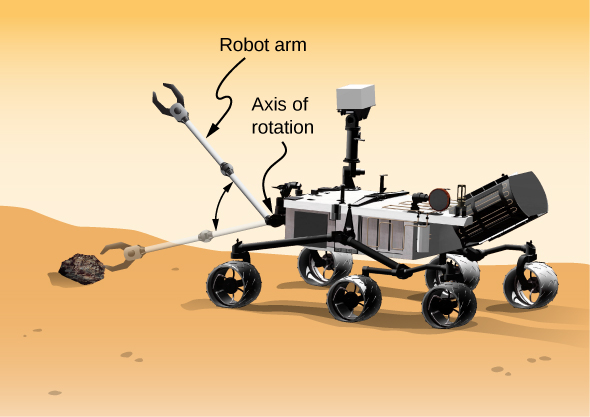
Strategy
We use (Figure) to find angular momentum in the various configurations. When the arm is rotating downward, the right-hand rule gives the angular momentum vector directed out of the page, which we will call the positive z-direction. When the arm is rotating upward, the right-hand rule gives the direction of the angular momentum vector into the page or in the negative z-direction. The moment of inertia is the sum of the individual moments of inertia. The arm can be approximated with a solid rod, and the forceps and Mars rock can be approximated as point masses located at a distance of 1 m from the origin. For part (c), we use Newton’s second law of motion for rotation to find the torque on the robot arm.
Solution
- Writing down the individual moments of inertia, we have
Robot arm:

Forceps:

Mars rock:

Therefore, without the Mars rock, the total moment of inertia is

and the magnitude of the angular momentum is

The angular momentum vector is directed out of the page in the
 direction since the robot arm is rotating counterclockwise.
direction since the robot arm is rotating counterclockwise. - We must include the Mars rock in the calculation of the moment of inertia, so we have

and

Now the angular momentum vector is directed into the page in the
 direction, by the right-hand rule, since the robot arm is now rotating clockwise.
direction, by the right-hand rule, since the robot arm is now rotating clockwise. - We find the torque when the arm does not have the rock by taking the derivative of the angular momentum using (Figure)
 But since
But since  , and understanding that the direction of the angular momentum and torque vectors are along the axis of rotation, we can suppress the vector notation and find
, and understanding that the direction of the angular momentum and torque vectors are along the axis of rotation, we can suppress the vector notation and find

which is Newton’s second law for rotation. Since
 , we can calculate the net torque:
, we can calculate the net torque:
Significance
The angular momentum in (a) is less than that of (b) due to the fact that the moment of inertia in (b) is greater than (a), while the angular velocity is the same.
Check Your Understanding Which has greater angular momentum: a solid sphere of mass m rotating at a constant angular frequency ![]() about the z-axis, or a solid cylinder of same mass and rotation rate about the z-axis?
about the z-axis, or a solid cylinder of same mass and rotation rate about the z-axis?
![]() ; Taking the ratio of the angular momenta, we have:
; Taking the ratio of the angular momenta, we have:
![]() . Thus, the cylinder has
. Thus, the cylinder has ![]() more angular momentum. This is because the cylinder has more mass distributed farther from the axis of rotation.
more angular momentum. This is because the cylinder has more mass distributed farther from the axis of rotation.
Visit the University of Colorado’s Interactive Simulation of Angular Momentum to learn more about angular momentum.
Summary
- The angular momentum
 of a single particle about a designated origin is the vector product of the position vector in the given coordinate system and the particle’s linear momentum.
of a single particle about a designated origin is the vector product of the position vector in the given coordinate system and the particle’s linear momentum. - The angular momentum
 of a system of particles about a designated origin is the vector sum of the individual momenta of the particles that make up the system.
of a system of particles about a designated origin is the vector sum of the individual momenta of the particles that make up the system. - The net torque on a system about a given origin is the time derivative of the angular momentum about that origin:
 .
. - A rigid rotating body has angular momentum
 directed along the axis of rotation. The time derivative of the angular momentum
directed along the axis of rotation. The time derivative of the angular momentum  gives the net torque on a rigid body and is directed along the axis of rotation.
gives the net torque on a rigid body and is directed along the axis of rotation.
Conceptual Questions
Can you assign an angular momentum to a particle without first defining a reference point?
For a particle traveling in a straight line, are there any points about which the angular momentum is zero? Assume the line intersects the origin.
All points on the straight line will give zero angular momentum, because a vector crossed into a parallel vector is zero.
Under what conditions does a rigid body have angular momentum but not linear momentum?
If a particle is moving with respect to a chosen origin it has linear momentum. What conditions must exist for this particle’s angular momentum to be zero about the chosen origin?
The particle must be moving on a straight line that passes through the chosen origin.
If you know the velocity of a particle, can you say anything about the particle’s angular momentum?
Problems
A 0.2-kg particle is travelling along the line ![]() with a velocity
with a velocity ![]() . What is the angular momentum of the particle about the origin?
. What is the angular momentum of the particle about the origin?
A bird flies overhead from where you stand at an altitude of 300.0 m and at a speed horizontal to the ground of 20.0 m/s. The bird has a mass of 2.0 kg. The radius vector to the bird makes an angle ![]() with respect to the ground. The radius vector to the bird and its momentum vector lie in the xy-plane. What is the bird’s angular momentum about the point where you are standing?
with respect to the ground. The radius vector to the bird and its momentum vector lie in the xy-plane. What is the bird’s angular momentum about the point where you are standing?
The magnitude of the cross product of the radius to the bird and its momentum vector yields ![]() , which gives
, which gives ![]() as the altitude of the bird h. The direction of the angular momentum is perpendicular to the radius and momentum vectors, which we choose arbitrarily as
as the altitude of the bird h. The direction of the angular momentum is perpendicular to the radius and momentum vectors, which we choose arbitrarily as ![]() , which is in the plane of the ground:
, which is in the plane of the ground:
![]()
A Formula One race car with mass 750.0 kg is speeding through a course in Monaco and enters a circular turn at 220.0 km/h in the counterclockwise direction about the origin of the circle. At another part of the course, the car enters a second circular turn at 180 km/h also in the counterclockwise direction. If the radius of curvature of the first turn is 130.0 m and that of the second is 100.0 m, compare the angular momenta of the race car in each turn taken about the origin of the circular turn.
A particle of mass 5.0 kg has position vector ![]() at a particular instant of time when its velocity is
at a particular instant of time when its velocity is ![]() with respect to the origin. (a) What is the angular momentum of the particle? (b) If a force
with respect to the origin. (a) What is the angular momentum of the particle? (b) If a force ![]() acts on the particle at this instant, what is the torque about the origin?
acts on the particle at this instant, what is the torque about the origin?
a. ![]() ;
;
b. ![]()
Use the right-hand rule to determine the directions of the angular momenta about the origin of the particles as shown below. The z-axis is out of the page.
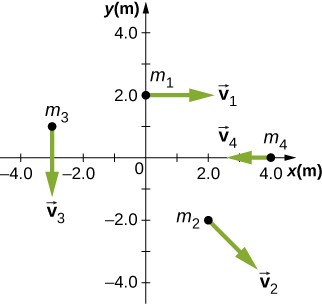
Suppose the particles in the preceding problem have masses ![]()
![]() . The velocities of the particles are
. The velocities of the particles are ![]() ,
, ![]() ,
, ![]() ,
, ![]() . (a) Calculate the angular momentum of each particle about the origin. (b) What is the total angular momentum of the four-particle system about the origin?
. (a) Calculate the angular momentum of each particle about the origin. (b) What is the total angular momentum of the four-particle system about the origin?
a. ![]() ,
, ![]() ,
,
![]() ; b.
; b. ![]()
Two particles of equal mass travel with the same speed in opposite directions along parallel lines separated by a distance d. Show that the angular momentum of this two-particle system is the same no matter what point is used as the reference for calculating the angular momentum.
An airplane of mass ![]() flies horizontally at an altitude of 10 km with a constant speed of 250 m/s relative to Earth. (a) What is the magnitude of the airplane’s angular momentum relative to a ground observer directly below the plane? (b) Does the angular momentum change as the airplane flies along its path?
flies horizontally at an altitude of 10 km with a constant speed of 250 m/s relative to Earth. (a) What is the magnitude of the airplane’s angular momentum relative to a ground observer directly below the plane? (b) Does the angular momentum change as the airplane flies along its path?
a. ![]() ; b. No, the angular momentum stays the same since the cross-product involves only the perpendicular distance from the plane to the ground no matter where it is along its path.
; b. No, the angular momentum stays the same since the cross-product involves only the perpendicular distance from the plane to the ground no matter where it is along its path.
At a particular instant, a 1.0-kg particle’s position is ![]() , its velocity is
, its velocity is ![]() , and the force on it is
, and the force on it is ![]() . (a) What is the angular momentum of the particle about the origin? (b) What is the torque on the particle about the origin? (c) What is the time rate of change of the particle’s angular momentum at this instant?
. (a) What is the angular momentum of the particle about the origin? (b) What is the torque on the particle about the origin? (c) What is the time rate of change of the particle’s angular momentum at this instant?
A particle of mass m is dropped at the point ![]() and falls vertically in Earth’s gravitational field
and falls vertically in Earth’s gravitational field ![]() (a) What is the expression for the angular momentum of the particle around the z-axis, which points directly out of the page as shown below? (b) Calculate the torque on the particle around the z-axis. (c) Is the torque equal to the time rate of change of the angular momentum?
(a) What is the expression for the angular momentum of the particle around the z-axis, which points directly out of the page as shown below? (b) Calculate the torque on the particle around the z-axis. (c) Is the torque equal to the time rate of change of the angular momentum?
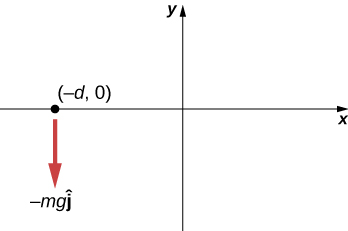
a. ![]() ;
;
b. ![]() ; c. yes
; c. yes
(a) Calculate the angular momentum of Earth in its orbit around the Sun. (b) Compare this angular momentum with the angular momentum of Earth about its axis.
A boulder of mass 20 kg and radius 20 cm rolls down a hill 15 m high from rest. What is its angular momentum when it is half way down the hill? (b) At the bottom?
a. ![]() ;
;
![]() ;
;
![]() ;
;
b. ![]() ;
;
![]()
A satellite is spinning at 6.0 rev/s. The satellite consists of a main body in the shape of a sphere of radius 2.0 m and mass 10,000 kg, and two antennas projecting out from the center of mass of the main body that can be approximated with rods of length 3.0 m each and mass 10 kg. The antenna’s lie in the plane of rotation. What is the angular momentum of the satellite?
A propeller consists of two blades each 3.0 m in length and mass 120 kg each. The propeller can be approximated by a single rod rotating about its center of mass. The propeller starts from rest and rotates up to 1200 rpm in 30 seconds at a constant rate. (a) What is the angular momentum of the propeller at ![]() (b) What is the torque on the propeller?
(b) What is the torque on the propeller?
a. ![]() ;
; ![]() ;
;
![]() ;
; ![]() ;
;
![]() ;
;
b. ![]()
A pulsar is a rapidly rotating neutron star. The Crab nebula pulsar in the constellation Taurus has a period of ![]() , radius 10.0 km, and mass
, radius 10.0 km, and mass ![]() The pulsar’s rotational period will increase over time due to the release of electromagnetic radiation, which doesn’t change its radius but reduces its rotational energy. (a) What is the angular momentum of the pulsar? (b) Suppose the angular velocity decreases at a rate of
The pulsar’s rotational period will increase over time due to the release of electromagnetic radiation, which doesn’t change its radius but reduces its rotational energy. (a) What is the angular momentum of the pulsar? (b) Suppose the angular velocity decreases at a rate of ![]() . What is the torque on the pulsar?
. What is the torque on the pulsar?
The blades of a wind turbine are 30 m in length and rotate at a maximum rotation rate of 20 rev/min. (a) If the blades are 6000 kg each and the rotor assembly has three blades, calculate the angular momentum of the turbine at this rotation rate. (b) What is the torque require to rotate the blades up to the maximum rotation rate in 5 minutes?
a. ![]() ;
;
b. ![]()
A roller coaster has mass 3000.0 kg and needs to make it safely through a vertical circular loop of radius 50.0 m. What is the minimum angular momentum of the coaster at the bottom of the loop to make it safely through? Neglect friction on the track. Take the coaster to be a point particle.
A mountain biker takes a jump in a race and goes airborne. The mountain bike is travelling at 10.0 m/s before it goes airborne. If the mass of the front wheel on the bike is 750 g and has radius 35 cm, what is the angular momentum of the spinning wheel in the air the moment the bike leaves the ground?
![]()
Glossary
- angular momentum
- rotational analog of linear momentum, found by taking the product of moment of inertia and angular velocity
